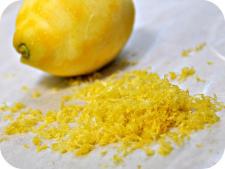-

zest
| Food | Percentage of DRI per 100 grams | |
|---|---|---|
Zest is the outer layer of the rind of citrus fruits such as lemon, lime, orange or tangerines. If your recipe calls for zest, make sure that you use a fruit that is organically grown since most conventionally grown citrus fruits will have pesticide residues or wax on their skin and may be artificially colored. After washing and drying the fruit, use a zester, microplane, paring knife or vegetable peeler to remove the zest. Make sure not to remove too much of the peel as the white pith underneath is bitter and could ruin the taste of the food. The zest can then be more finely chopped or minced if necessary.
Zest can brighten up practically any dish. You can add it to desserts, salads, dressings, rice, pasta, salt, baked goods, drinks, garnish and so much more. It is recommended to zest before using the fruit rather than after.
STORING
Orange zest can be stored for later use. It can be stored in the refrigerator for up to a week or in the freezer for months. You can also dry it in a dehydrator and then store in an airtight container or zip-lock bag in a cool, dry place for months.
ORANGE ZEST
Oranges do not necessarily have to have a bright orange color to be ripe. In fact, the uniform color of non-organic oranges is sometimes due to injection of artificial food dye Citrus Red Number 2. Green oranges may be just as ripe and tasty as those that are solid orange in color. And, because oranges are among the top 20 foods in which pesticide residues are most frequently found, it is wise to buy organic oranges whenever possible.
HEALTH BENEFITS
What few people know is that most of the phytonutrient in citrus is found in the peel and pith, rather than in its flesh. So the zest is not just great for it´s taste, but also for its nutritional density. According to a study by U.S. and Canadian researchers published in the Journal of Agricultural and Food Chemistry, compounds (flavones) in the peel of citrus fruit have the potential of lowering cholesterol even more efficiently than certain prescription medications, including Statin drugs. Based on the results in cell studies, the flavones inhibit the synthesis of cholesterol and triglycerides inside the liver, just like Statin drugs. Treatment with citrus flavones did not have any effect on levels of beneficial HDL cholesterol, and no negative side effects were seen. Using the zest from an organic citrus fruit on a daily basis to add to your salad, dressing, soup, dessert, granola or smoothie is a wonderful way to achieve cholesterol lowering benefits.